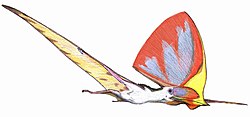| Germanodactylids Temporal range: | |
|---|---|
 | |
| Fossil specimen of Germanodactylus cristatus | |
| Scientific classification | |
| Kingdom: | Animalia |
| Phylum: | Chordata |
| Class: | Reptilia |
| Order: | † Pterosauria |
| Suborder: | † Pterodactyloidea |
| Infraorder: | † Archaeopterodactyloidea |
| Family: | † Germanodactylidae Yang, 1964 |
| Type species | |
| † Pterodactylus cristatus Wiman, 1925 | |
| Subgroups | |
Germanodactylidae is a controversial group of pterosaurs within the suborder Pterodactyloidea. It was first named by Yang Zhongjian in 1964, and given a formal phylogenetic definition in 2014 by Brian Andres, James Clark, and Xu Xing. They defined it as the least inclusive clade containing Germanodactylus cristatus and Normannognathus wellnhoferi , which they considered to be close relatives at the time. [1] However, more recent studies by the same researchers have found that these pterosaurs may be only distantly related.
Studies performed in the 2000s suggested this group it contained three genera: Germanodactylus , Normannognathus and Tendaguripterus . Various studies have since placed these pterosaurs within the larger clades Archaeopterodactyloidea, [1] [2] [3] Eupterodactyloidea, or Dsungaripteroidea, [4] though it has also been recovered within the Ctenochasmatoidea. [5] In several 2010s studies, the supposed "germanodactylid" species were not necessarily found to form a natural group with each other, and even the genus Germanodactylus itself was discovered to be likely paraphyletic, causing one of its component species to be renamed Altmuehlopterus . This would render the name Germanodactylidae synonymous with some other clade, such as Eupterodactyloidea or Lophocratia. [3] [6]












